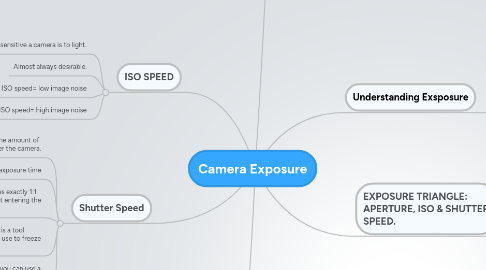Camera Exposure
Door Giovanna Wilson


1. Shutter Speed
1.1. Shutter speed is the amount of time light can enter the camera.
1.2. Faster speed = shorter exposure time
1.3. Shutter speed correlates exactly 1:1 with the amount of light entering the camera.
1.3.1. EX: When shutter speed doubles the amount of light entering the camera also doubles.
1.4. Shutter Speed is a tool photographers use to freeze motion.
1.5. If a photo is blurry you can use a tripod or increase shutter speed.
2. APERTURE SETTING
2.1. In a camera lenshe area of the opening increases as the f-stop decreases.
2.2. Every time the f-stop value halves, the light-collecting area quadruples.
2.3. A narrow aperture range usually isn't a big problem, but a greater range does provide for more creative flexibility.
2.4. A camera's aperture setting is what determines a photo's depth of field
3. ISO SPEED
3.1. How sensitive a camera is to light.
3.2. Almost always desirable.
3.3. Low ISO speed= low image noise
3.4. High ISO speed= high image noise
4. CAMERA EXPOSURE MODES
4.1. Auto (), Program (P), Aperture Priority (Av), Shutter Priority (Tv), Manual (M) and Bulb (B) mode. Av, Tv, and M are often called "creative modes" or "auto exposure (AE) modes.
4.2. Auto: all exposure settings selected
4.3. Program: Selects aperture and shutter speed
4.4. Aperture Priority: specify the aperture & ISO
4.5. Shutter Priority:specify the shutter speed & ISO
4.6. Manuel:You specify the aperture, ISO and shutter speed
4.7. Bulb: Useful for exposures longer than 30 seconds.
4.8. Preset modes: landscape, portrait, sports and night mode
4.8.1. Portrait: Camera tries to pick the lowest f-stop value possible for a given exposure.
4.8.2. Landscape:Camera tries to pick a high f-stop to ensure a large depth of field
4.8.3. Sports:Camera tries to achieve as fast a shutter speed as possible for a given exposure — ideally 1/250 seconds or faster.
4.8.4. Night mode: Camera permits shutter speeds which are longer than ordinarily allowed for hand-held shots, and increases the ISO speed to near its maximum available value.
